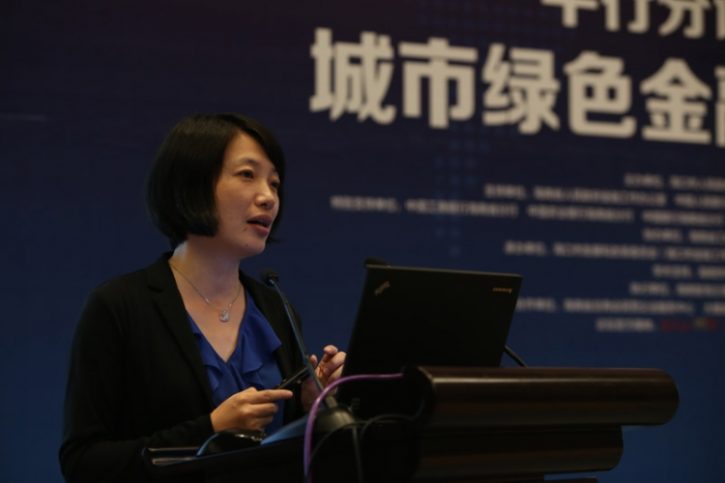
Professor Yao Wang is the Director General of International Institute of Green Finance (IIGF) and the Director of the Research Center for Climate and Energy Finance (RCCEF) at the Central University of Finance and Economics (CUFE). She is also the Deputy Secretary General of Green Finance Committee (GFC) of China Society for Finance and Banking.

- What are major trends ahead for green finance in China?
First, the policy system continues to improve. Since the 2016 release of the Guidelines for Establishing the Green Financial System, each government department has been developing and implementing policies at increasing levels of detail. There has been progress with regard to mandatory environmental information disclosure for listed companies. In 2017, listed companies identified by the Ministry of Environmental Protection (now Ministry of Ecological Environment) as significant polluters were required to disclose and this year, all listed companies are requested to disclose and provide justification—more than 90% are expected to comply or face repercussions. By 2020, it will be mandatory for all listed companies to disclose, a significant step in transparency for financial stakeholders since most large Chinese companies are publicly listed, even state-owned enterprises.
Second, a number of green finance tools—green credit, green bonds, green insurance—and methodologies of environmental stress testing, ESG integration, and environmental credits are maturing and becoming ubiquitous. In particular, environmental rights trading has developed for emission and water rights, namely the scaling up of China’s national carbon trading system that was announced in December 2017. The announcement was a step towards its realization and it noted the first year would be used to establish the basis for the exchange system such as registration, a common system, processes, and standards. The next step in the system will be launched as a simulation to prepare stakeholders for the official rollout. The full-fledged carbon market should be in place in about 2-3 years.
Chinese investors are beginning to integrate ESG considerations in decisions, but the major challenge remains convincing investors of the profitability of sustainable investments. Green investments are often perceived as riskier, but this is not necessarily the case as highlighted by the G20 Green Finance Study Group that met in Hangzhou in September 2016. As part of this process, IIGF, UNEP FI, and UNPRI have a paper on ESG integration in the Chinese asset management industry.
Local green finance is another evolving trend including designated green finance pilot zones and numerous voluntary programs in Beijing, Xiamen, Sichuan, the Yangtze River Delta, and the Greater Bay area. Such initiatives are predicted to be rapidly scaled up over the next years.
Lastly, the Belt and Road Initiative (BRI) continues to stress the inclusion of critical green components. Official notices such as the Environmental Risk Management Initiative for China’s Overseas Investment issued by the China Green Finance Committee (GFC) and Guidance on Promoting Green Belt and Road by the State Council show the intent of a green BRI, which would be welcomed by international stakeholders.
- As China continues to be an emerging leader in green finance, what are the global implications?
Chinese commitment is a strong policy signal to global stakeholders and China’s green finance activities multilaterally, bilaterally, and through the BRI continue to have a global impact. Through the G20 and BRI, China has been a pioneer in pushing the agenda for greening the financial system. These combined efforts, including partnerships with international organizations such as UNEP, have great implications for scaling up green finance at a global level. Bilaterally, China is working with the EU and the UK to promote green finance globally.
Green bond standards are a concrete example of China’s emergence as a global leader in green finance. As the world’s second largest green bond market, the increasing internationalization of Chinese bond issuers and investors are influencing global standards. In this regard, it is important to note that as countries have varying levels of development, economic structures, and energy systems, they will have different definitions of green. However, there are recent efforts to harmonize these differences, which suggests the desire to achieve consistent international green bond standards.
China’s increasing green investment overseas has created and co-created 15 funds worth almost $150 billion. There are two funds specifically tied to green development, South-South Climate Cooperation Fund and U.S.-China Green Fund, which are primarily invested in developing countries, including Africa, Latin America, countries along the Belt and Road routes, and ASEAN.
- China launched five green finance pilot zones last year. Can you provide some insight on the latest happenings in the pilot zones? Are there any specific takeaways from the past year?
The pilot zones have achieved a good degree of initial progress. All pilot zones advanced supporting policies, organizational structures, products and services innovation, market construction and institutional development. This initial progress has led to the development of green finance policies and frameworks in ten other provinces and autonomous regions that were not part of the pilot program in response to the national-level emphasis for green finance.
Local green finance committees have played an active role in resource integration and coordination. Supported by national regulatory authorities, research institutes, and financial institutions, China’s GFC has called on local financial institutions to execute relevant training, liaison, cooperation, and promotion of best practices, exemplary cases and experiences in developing green finance. Currently, Xinjiang, Guangdong, Zhejiang and Gansu have all set up their own local green finance committees.
Other developments include the introduction of green finance incentive schemes in Guangdong, an innovative insurance system in Quzhou with potential to be scaled, and a green evaluation system in Huzhou. Xinjiang and a number of other locales have established green project pipeline platforms and Jiangxi province is promoting the marketization of ecology compensation through a trading system providing training for all relevant stakeholders.
- The International Institute of Green Finance (IIGF) is a recognized leader in green finance research, what exciting things are in store for this year?
The IIGF focuses on topics related to greening the Chinese and international financial system and research work falls into three categories—green, climate, and energy. First, in our green finance work, we have published an annual report with UNEP on the progress of China’s green financial system and a yearly review of green bonds in China. We are currently doing research on green finance in the Greater Bay Area, environmental rights trading, green trade finance, green indexes, ESG integration, green investment performance, and plan to publish these findings. On climate research, IIGF will soon publish a 2017 year in review of climate finance, a separate work on Chinese perspectives of climate finance, and the latest on China’s carbon trading market. IIGF’s energy research centers on sustainable energy finance in the BRI, and will also be publishing a 2017 year in review report of energy financing in China.
- Which living person do you most admire and why?
I greatly admire Dr. Ma Jun, Director of the Center for Finance and Development of the Tsinghua National Institute of Financial Research, and Chair of the China GFC of China Society for Finance and Banking. He was the former Chief Economist of PBOC and is the Chair of the IIGF’s academic committee. His commitment to improving the environment of China and ability to think strategically about the big picture is admirable. His professionalism has made him a key influence and shaper of green finance in China and abroad. Lastly, I admire his sense for the arts, kindness, and humility in the face of both success and failure.


